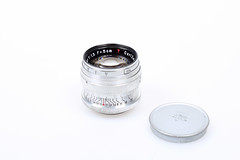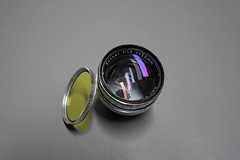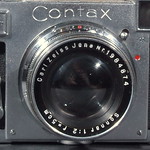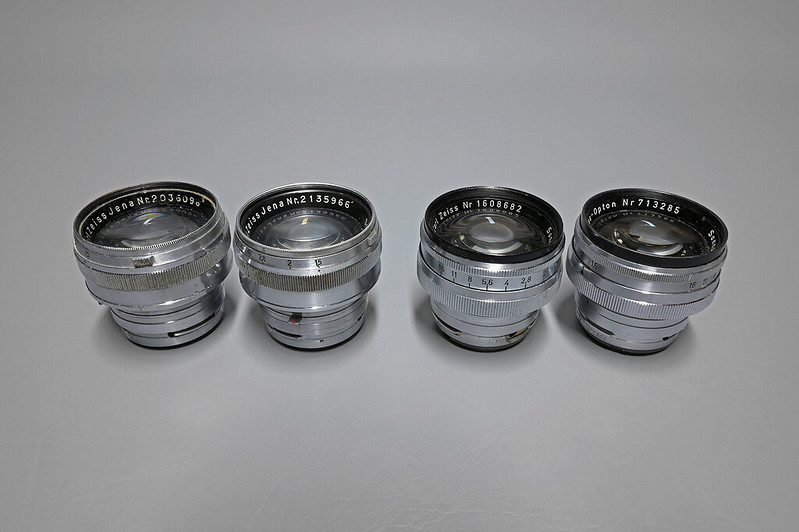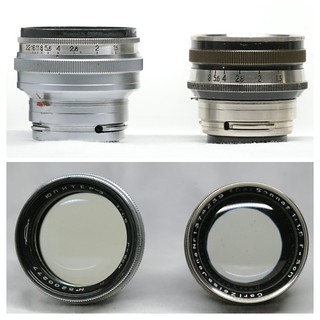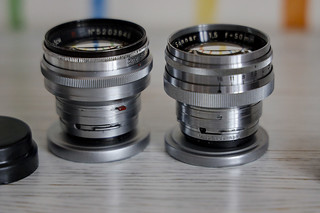Sonnar 50mm
The name Sonnar comes from the German word Sonne (=sun). The Sonnar 50mm lens made by Carl Zeiss Jena from 1932 for the Contax rangefinder cameras was a complete redesign of an earlier Tessar-type lens bearing that name. The new Sonnar's lens design was no more based on the Tessar but instead derived from the Ernostar, resulting in a new lens type, the Sonnar type. At the time it was introduced, the Sonnar for the Contax was the fastest lens available, with a maximum aperture of f/1.5. A fast f/2.0 budget version was also made.
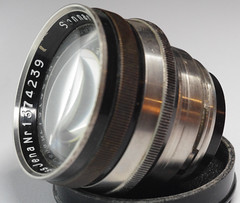
|
| Sonnar 50/1.5 Type1 (1932) aperture only 1.5 to 8 image by Pablo Coronel (Image rights) |
Contents
Design history
This is a design by Ludwig Bertele, who invented the fast Ernostar at Ernemann in Dresden. After the merge of Ernemann into Zeiss-Ikon he became employee of Carl Zeiss. The Sonnar's first conception was a five-element lens and appears in the first patents for that lens type. The first post-prototype Sonnar design of 1931 with lens speed f/2 has 6 elements in 3 groups: one group with a single element and two groups of cemented elements.[1]. Coating of lens surfaces to avoid light reflection wasn't in use at that time, so that reflections in the air spaces between lens groups could cause unlimited flare, and also meant light losses.
One advantage of the new Sonnar compared to the Ernostar was the reduction of lens groups from four to three, thus having one air space less in the optical path of the incoming light. Bertele did move one of the Ernostar's single elements behind the aperture and cemented it with the lens back element. For the very fast f/1.5 Sonnar version he added another element to that lens back group. The genius of the inventor was shown in the fact that he had achieved two impressive advantages with the Sonnar: Very high effective lens speed combined with less flare.
The lens was first introduced in 1932 in black and nickel finish with a run of 155 [2]. The aperture ring is in the center of the lens. The lens has a diameter of 40.5mm internal and uses 42mm push-on filters. To avoid contrast problems due to diffraction, the min. aperture was limited to f/8. Iris has 16 blades.
The second version (1933) was slightly different optically and cosmetically, while still black and chrome it can be identified by the minimum aperture being changed to f/11. Bertele introduced slight changes in the formula and reduced the risk of diffraction. [2]
The third version (1935) also saw optical and cosmetic changes. The barrel was changed to black, nickel and chrome and the front was threaded to accept 40.5mm filters, the aperture ring was moved to the front of the lens, and two little finger grips (ears). The iris has 13 blades from this model onwards. The minimum aperture was maintained at f/11, even though some go to f/16 after optical optimization.
Later that year the fourth version appeared. It was identical to the third version, except it was finished entirely in chrome. This is the most common prewar design. With this model, coating on the lenses began to be applied in the later models.
During the war, several variations were produced with cosmetic changes due to shortages of certain materials. In 1941 a version was produced with an aluminum aperture ring, and a nickel plated barrel. In 1942 other variations were produced, the first with a black filter ring. And a second in which the entire barrel was made from aluminum. And in 1943 a chrome lens was built without the finger grips on the aperture ring, and of a design that would reappear after the war. [3]
|
|
|
After the war Zeiss was split between East and West Germany. The west Germany branch relaunched the lens as Zeiss-Opton around 1950. These lenses had a new optical design, and were coated (red T). The body was chrome over brass.
A black filter ring was added from 1951 and around 1952 a version with apertures that stopped to f/22 was introduced. The final type of lenses were built in 1953. They were no longer marked Zeiss-Opton as Zeiss Ikon regained the rights to use the "Carl Zeiss" brand, had no ears for the aperture ring and stopped down to f/16.
|
In 2006 Carl Zeiss launched a new camera with Leica M mount, and revived the lens as Carl Zeiss T* Sonnar 50 mm 1.5 ZM. This lens was a modern version of the Sonnar, with improved coating and a new optical formula, and was available in Leica and Contax mounts. It has since become a cult lens. [4][5]
Soviet Copies
After World War II, the USSR took the Zeiss plants as spoils of war and moved them to Ukraine (Kiev). The Carl Zeiss Sonnar saw new life first as ZK (Sonnar Krasnogor) and then as Jupiter-3 in Contax/Kiev, Leica/Zorki, Leica M and even M42 mount and was built until 1988. These lenses are made of aluminium and plastic.
A new version called Jupiter 3+ was issued by Lomography in 2018 and is made in the Zenit factory.[6] This new version has multicoated lenses and aluminium body in Leica M39 mount.
|
|
Notes
- ↑ Sonnar page by Marco Kröger M.A.
- ↑ 2.0 2.1 Thiele Harmut. 2010. Fabrikationsbuch Photooptik Volume 2
- ↑ Pacific Rim Camera photographica page on the Sonnar 5cm f/1.5
- ↑ Detailed review of the ZM Sonnar 50/1.5 at Phillipreeve.net
- ↑ The ZM Sonnar by Henry Scherer
- ↑ Jupiter 3+ at Lomography
Links
- Sonnar 50/1.5 pages by Roy Milde
